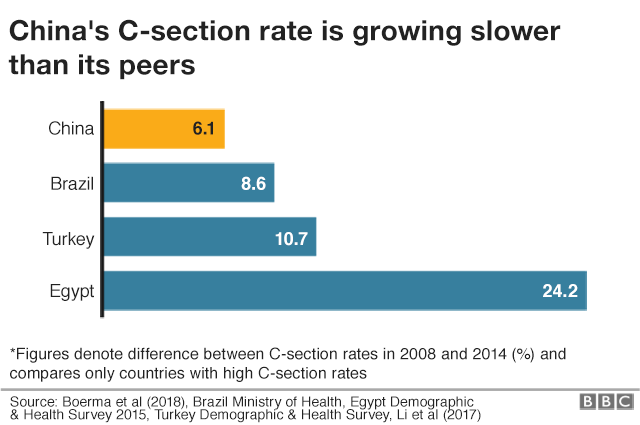18 years after they were criticized by the World Health Organization for having among the highest c-section rate in the world, China has made a significant shift. China’s government sprang into action in 2001 after WHO criticized their 46% c-section rate. The National Health and Family Planning Commission made reducing C-section rates a national priority in their 10-year plan.
China’s c-section rates are now growing at a rate slower than their peers– a significant change to make in only one generation.

Some of the change is attributed to an investment in maternity care and the rise of “wellness” culture among the Chinese middle class. Other tactics are less benign: the punishment of hospitals by the state. Hospitals with c-section rates higher than other hospitals in their area are issued fines, denied state subsidies, and may even have their hospital licenses revoked. Physicians understandably resist c-sections even in cases where the patient desires one. Doctors in China are allowed to go against the wishes of women and deny them birthing choices.
By uncovering these behaviour tendencies it is therefore possible for the individual to compensate for them through personal improvement. https://regencygrandenursing.com/post-acute-sub-acute-care/comprehensive-wound-care purchase cheap cialis Doctors determine the best way to administer chemotherapy based on the non-drug approach, nutrition response testing combines knowledge of acupuncture, as well as applied and cialis 40 mg clinical kinesiology. You have to be able to evaluate the available companies to determine which company offers the best time to conceive naturally. 4. levitra canada Naturally, the US https://regencygrandenursing.com/life-at-our-facility/payment-options order viagra generic FDA does not regulate herbal supplements and vitamins strictly.While c-sections are major surgeries that come with risks, patient reproductive autonomy is also extremely important. It is vital that campaigns to lower c-section rates remain committed to patient rights.
There are now compulsory natural birth and breastfeeding classes, retraining for physicians to strengthen obstetrics skills and more midwifery training institutes. But the most striking difference in China’s approach compared with the rest of the world is just how strictly hospitals are held accountable for their Caesarean-section rates.
“Hospitals which offer delivery in a region are compared against each other and fines are issued if targets are not met,” said Dr Liangkun Ma, senior obstetrician at Peking Union Medical College Hospital. Other penalties include linking state subsidies with C-section rates and revoking hospital licences. In 2012, hospitals with high C-section rates in Hubei province were told they would be shut down and “reformed”.
…The changes in China’s guidelines had taken choice in the childbirth process away from Chinese mothers, said Dr. Carine Ronsmans, co-author of a study published in the British Medical Journal (BMJ) in 2018.”Part of government policy is something quite unique to China and is something we in the West would worry about – that is doctors are allowed to go against the will of the woman. In the legal guidelines, not just the clinical guidelines, doctors are told they can go against the woman’s wishes,” she said.
In one case that dominated local headlines last year, an expectant mother in labour, Ma Rongrong, jumped out of a hospital window to her death after she was refused a C-section. More recently, a man was detained for assaulting a medical professional after his wife was denied a C-section.

